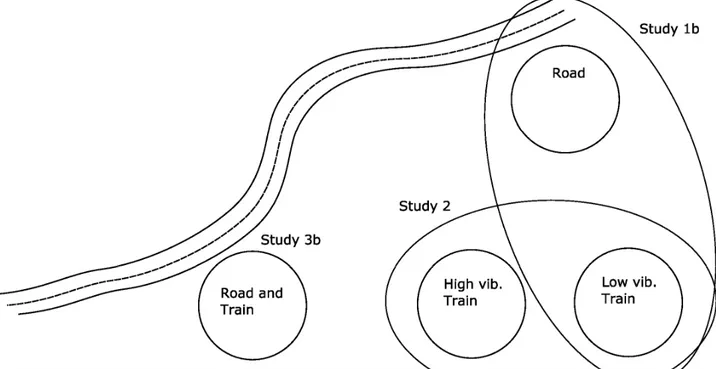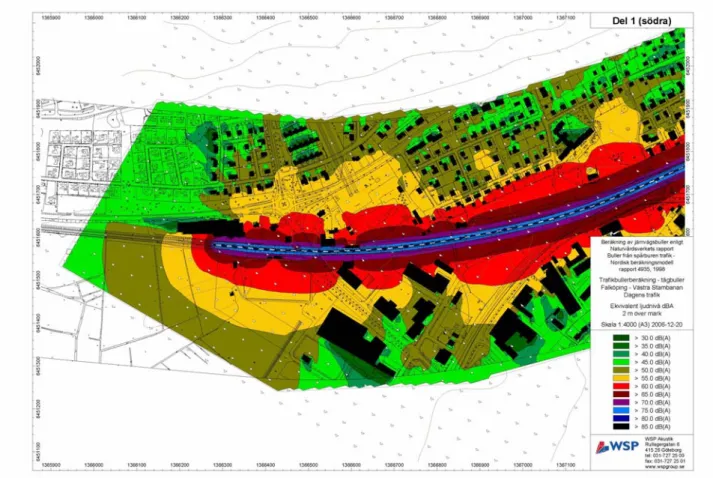T. Jerson, M. Ögren, E. Öhrström 1
Combined effects of noise and vibration from train and road traffic
Tomas Jerson (eng.) - WSP Environmental, Mikael Ögren (ph.d.) - Swedish National Road and Transport Institute, Evy Öhrström (m.d.)- Department of Occupational and Environmental Medicine at the Sahlgrenska University Hospital/Gothenburg UniversityBackground
Railway traffic causes both noise and vibrations in surrounding areas. To enable effective planning of reduction measures that may reduce adverse health effects, it is important to gain a better knowledge about the coupling of these effects to noise and vibration exposures from train and road traffic. These exposures may in fact increase in the future, due to increasing traffic intensity with both faster and heavier trains. The Swedish Rail Administration, Banverket has granted research resources to conduct a research project named TVANE, Train Vibration and Noise Exposure that has started in 2006 and will be carried out until 2010.
1. Purpose
The research project addresses three aims. The first is whether a “train bonus” can be expected, i.e. whether noise from railway traffic is perceived as less annoying than road traffic noise and the same level. The second aim is to investigate the connection between disturbance and exposure to simultaneous noise and vibration from train traffic. The third issue is to investigate concurrent effects from simultaneous exposure to noise from train and road traffic. The three aims are illustrated in figure 1 below.
T. Jerson, M. Ögren, E. Öhrström 2
2. Literature survey
A literature survey has been carried out (Öhrström & Skånberg 2006). The result of the survey gives an overview of knowledge in the area and also access to material of national and international investigations.
2.1 Studies of effects of railway noise compared with road traffic noise (train bonus)
An EU Position paper including European studies until 1993 states that a train bonus of 5 dB relative to road traffic noise is motivated. Studies in Europe carried out later shows contradictory results. French and German studies on the other hand shows results that do motivate a train bonus, particularly at noise levels higher than LAeq, 24h 65 dB. Japanese studies show that noise from
high-speed trains and conventional trains are more disturbing than noise from road traffic. A Austrian study supports the reason for train bonus at noise levels < Ldn 50 dB. The Swedish study in Lerum (Öhrström et al 2005) and a Dutch experimental study that compared noise from maglev trains and road traffic give no evidence for a train bonus.
The Japanese studies were carried out on railway lines with intense traffic, 500 – 800 trains per day. This corresponds to approximately one train per minute, and this intensity could help explain the difference between the Japanese and European results. Taken together, most of the results indicate there are several reasons to count on a train bonus when it comes to general noise disturbance and sleep disturbance, but not to speech interference.
2.2 Studies of effects of different vibration levels from train traffic
All field studies show that the disturbance from railway traffic is larger in areas with simultaneous vibrations. There is an interaction between noise and vibrations. The level of the vibration influences the noise disturbance but the disturbance of the vibrations is influenced in a more complex way than the noise disturbance. In some cases it was found that the vibration disturbance is more pronounced at low noise levels. In other cases, at high noise and vibrations levels, fewer vibration disturbances were observed, when the noise was masking and reduced the perception of vibrations.
2.3 Studies of effects of simultaneous exposure to noise from road and train traffic
Noise from two or more noise sources, for example railway and road traffic exists in many environments. For habitants or visitors, the effect of the composed noise environment is of vital importance. During expansion of new infrastructure, it is necessary to consider this fact to prevent and reduce the overall noise disturbance. Further research is needed for a more accurate estimation of the composed noise exposure and and how it interacts with other disturbances (than noise). Intense and simultaneous railway and road traffic reduce the amount of silent periods over a day and night. The silent periods are essential to allow for rest and recover.
3. Comparison studies of noise and vibration effects from train and road traffic
To determine whether there is an objective reason for higher recommendations on noise levels from railway traffic than from road traffic, a couple of studies have been planned. Within the frame of the second phase of the research program ”sound landscape for better health” (funded by Mistra,
T. Jerson, M. Ögren, E. Öhrström 3 the Swedish environmental strategic foundation), comparable studies will be carried out 2006 on the influence of noise from road and train traffic on the perceived disturbance and speech disturbance.
a) A reanalysis of an earlier study carried out in a Swedish village, Lerum (situated at one of the main railway lines, Västra Stambanan between Gothenburg and Stockholm, c f Öhrström et al 2005). In this study, data have been collected of nearly 2000 individuals exposed to train and road traffic noise. These data may be used again, to study populations exposed to road and train traffic noise in various levels from LAeq 24h, 45 - ≥ 65 dB.
b) A new field study is just on going in four villages. In Kungälv and Borås situated at two major roads (E6 and R40), the traffic noise is calculated from the main road up to a distance of 300 m. Noise measurements are also carried out at control points. In Falköping and Töreboda, situated at the “Västra Stambanan”, train noise is calculated from the main railway up to a distance of 300 m, figure 2. Noise measurements are also carried out at control points in this area. A questionnaire concerning noise disturbance from train and road traffic have been sent to 2000 people in the villages.
T. Jerson, M. Ögren, E. Öhrström 4 c) Experimental sleep studies with noise exposure from road and railway traffic will be carried out in a laboratory. The Department of Occupational and Environmental Medicine has built a new laboratory for sound exposures to individuals. It has three bedrooms, where in all eighteen test persons are going to sleep during four nights. The test persons will be exposed for train and road traffic noise according to a well defined scheme during those nights. The maximum noise level will be equal for both train and road traffic. Every morning each person fills in questionnaires about their observed sleeping quality. At every evening, each person also answers a questionnaire about their day, if they felt tired or stressed.
4. Studies of effect of different vibration levels from train traffic
To gain more knowledge of disturbance from train vibration in dwellings and the importance of interaction with train noise, two more studies have been planned.
a) Disturbance reactions from train vibration and interaction between train noise and vibration will be studied in different communities. Two types of community will be chosen, one with low
vibrations levels < 0.4 mm/s and one with high levels > 1.4 mm/s. It is desirable to carry out the studies at the same railway line. Geological maps, contacts with the Swedish Rail Administration and control measurements, will identify suitable areas. Possibly theoretical calculations will be carried out to predict expected vibrations levels in discrete houses. A couple of vibration measurements will be carried out in house where the people have answered that they are highly disturbed of train vibrations and also in houses were people answered the not disturbed at all.
b) Experimental sleep studies with vibration and noise exposure from railway traffic will be carried out in a laboratory. One bed will be equipped with a vibrator, that generates realistic vibrations from recorded train passages. The subjects of the study will be exposed to train vibrations and noise in four nights according to a well defined scheme.
5. Studies of effects of contemporaneous exposure for road and train noise
a) A reanalyse of an early study carried out in Lerum (Öhrström et al 2005). 619 subjects who were equally exposed to train and road noise can be selected from this study. The total noise exposure can be divided in to four intervals, LAeq, 24h 48-51, 52-55, 56-60 and 61-72 dB. Evaluation of effects
will be carried out according to the total sound environmental and disturbance in relation to respectively noise source.
b) A new field study will be carried out to investigate how train and road traffic noise interacts. The same questionnaire concerning noise disturbance from train and road traffic that were used in the Lerum study will be sent to 1000 people in the selected communities.
Acknowledgements
The authors would like to acknowledge the financial support from Banverket, the Swedish railway infrastructure manager and Sören Dahlén. The contributions of our reference group chaired by Karin Blidberg, Banverket.

